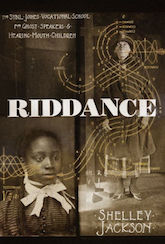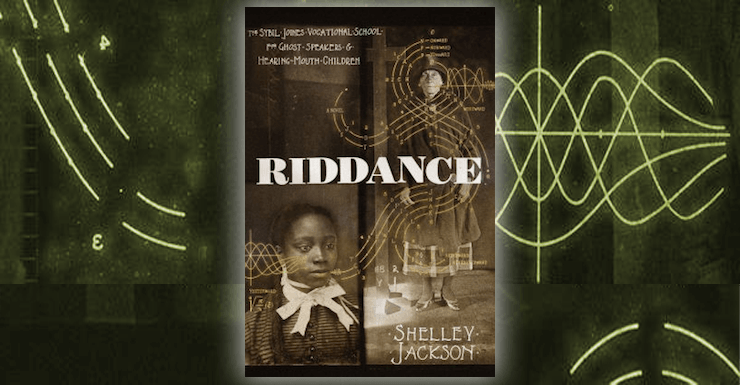Shelley Jackson has long been one of gothic fabulism’s most delightful and ambitious Renaissance persons. Her 1995 hypertext Patchwork Girl is a reimagining of Frankenstein by way of L. Frank Baum’s The Patchwork Girl of Oz, a labyrinthine and nonlinear rabbit-hole collage of quotations, allusions, and anatomical diagrams. In 2003 she began the novella Skin, published entirely as one-word tattoos on the bodies of several thousand volunteers; her ongoing novella project is written in snow. She is a visual artist who’s illustrated the covers and interiors of Kelly Link’s short story collections Stranger Things Happen and Magic for Beginners as well as her own children’s books. And her most conventional (in form, anyway) novel to date, Half-Life, is the story of conjoined twins Nora and Blanche, one of whom is on a murderous quest to take back the first-person singular pronoun.
Riddance is Jackson’s first novel in twelve years, and it’s as noisy, category-defying, and fantastically weird a book as a longtime Jackson fan might hope for.
While plot is not its chief concern, it is more or less organized around the happenings at the Sybil Joines Vocational School, a Massachusetts boarding school of dubious reputation whose increasingly sinister headmistress, Sybil Joines herself, collects children with speech impediments under the premise that they can be made to channel the voices of the dead. (“I reveled in counterfeit,” Joines tells us early on, suggesting that perhaps she is not quite so reliable a necronaut as she would have us believe.) Eleven-year-old biracial stutterer Jane Grandison, a family-less new student with outsize ambitions, becomes Joines’s stenographer and personal assistant; but her own motives are as complicated as Joines’s, and when children at the school start dying, her story takes on a cool counterfeit of its own.
Riddance is presented as an anthology of first-person testimonials and supporting documents: Jane Grandison’s records of Joines’s channeled utterances from the land of the dead, reports from a variety of school visitors on the school’s quack practices, necronautical textbooks, letters to dead authors, and Jane’s own recollections, which serve as a welcome anchor throughout the book’s gothic cacophony. It is a big, exuberant, gleeful book, whimsical and inventive and stuffed full of wild leaps from the land of the dead to the land of the living—which, in Jackson’s world, are not so very separate at all.
Buy the Book


Riddance
In places Riddance’s insistent intertextuality barrels off into the weeds; Sybil Joines in particular is fond of 19th-century digressions that can make even a die-hard Dickens fan a bit impatient. While Joines is hardly a sympathetic narrator, her abuses of and experiments on children with disabilities bear a nasty resemblance to real-world practices in 19th-century institutions, a parallel that goes largely unexplored in the book. And though Jane Grandison offers a number of sharp insights into the operations of race and class, including a savagely funny indictment of the unrelenting whiteness of Sybil Joines’s dead (“Does the afterlife, too, hold up Jim Crow?” she offers drily), her most pointed critique only comes halfway through the book and is then mostly set aside.
But the book’s heart is a sad and tangled story of two heartsick misfits finding their own ways to survive, and Jackson always brings us back to its most compelling elements: the intersections and divergences of Jane and Sybil’s devastating loneliness and indomitable wills. As the book progresses—and the school falls apart—their stories surface more and more insistently, carrying the reader through to a bittersweet end.
While Riddance begins as a sometimes grotesque and always clever meditation on living, dying, and writing fiction, its heart is something sadder and less cerebral—an investigation into the way that damage and trauma reroute human lives. Is Sybil Joines channeling the voices of the restless dead, or only her own brutal history? That’s a question the reader will have to answer for herself. But it’s not just the dead who haunt the living, Jackson reminds us, and in the end the only story we can truly tell is our own.
Riddance is available from Black Balloon Publishing.
Sarah McCarry is the author of three novels: All Our Pretty Songs, a Tiptree Award honoree; the Norton award-nominated Dirty Wings; and the Lambda award-nominated About A Girl.










